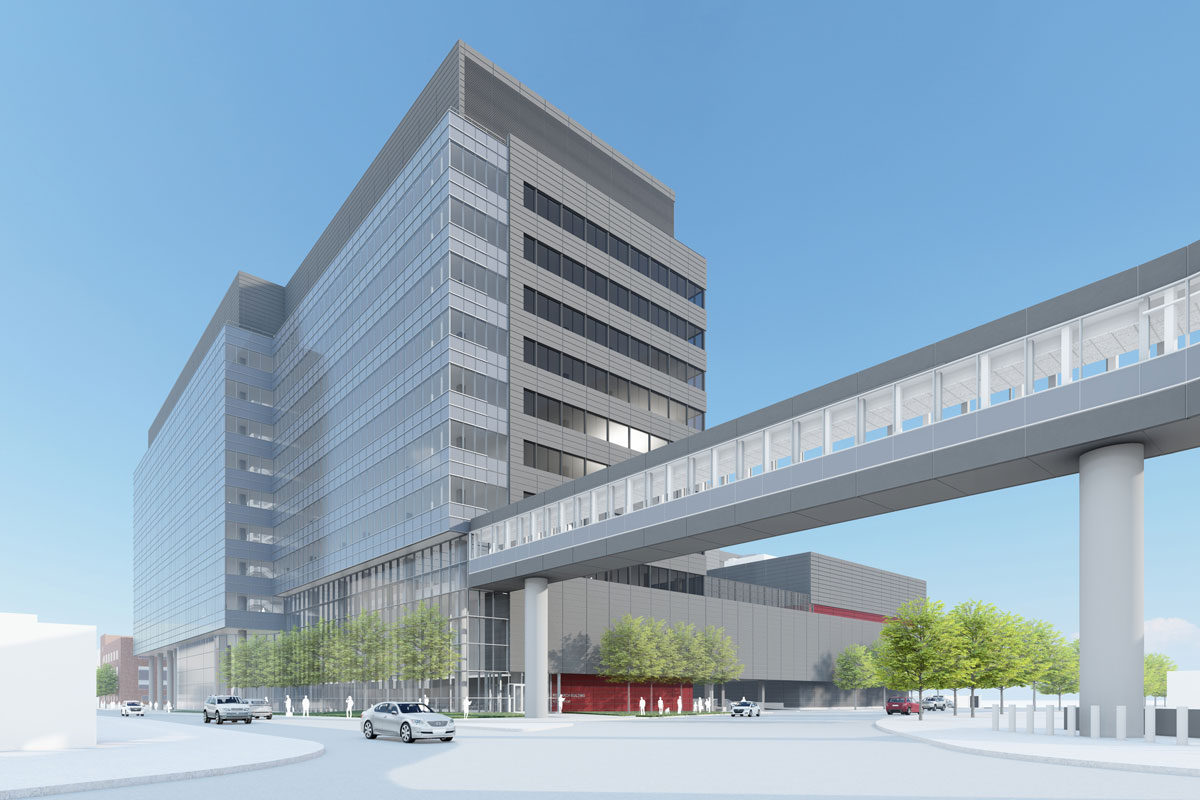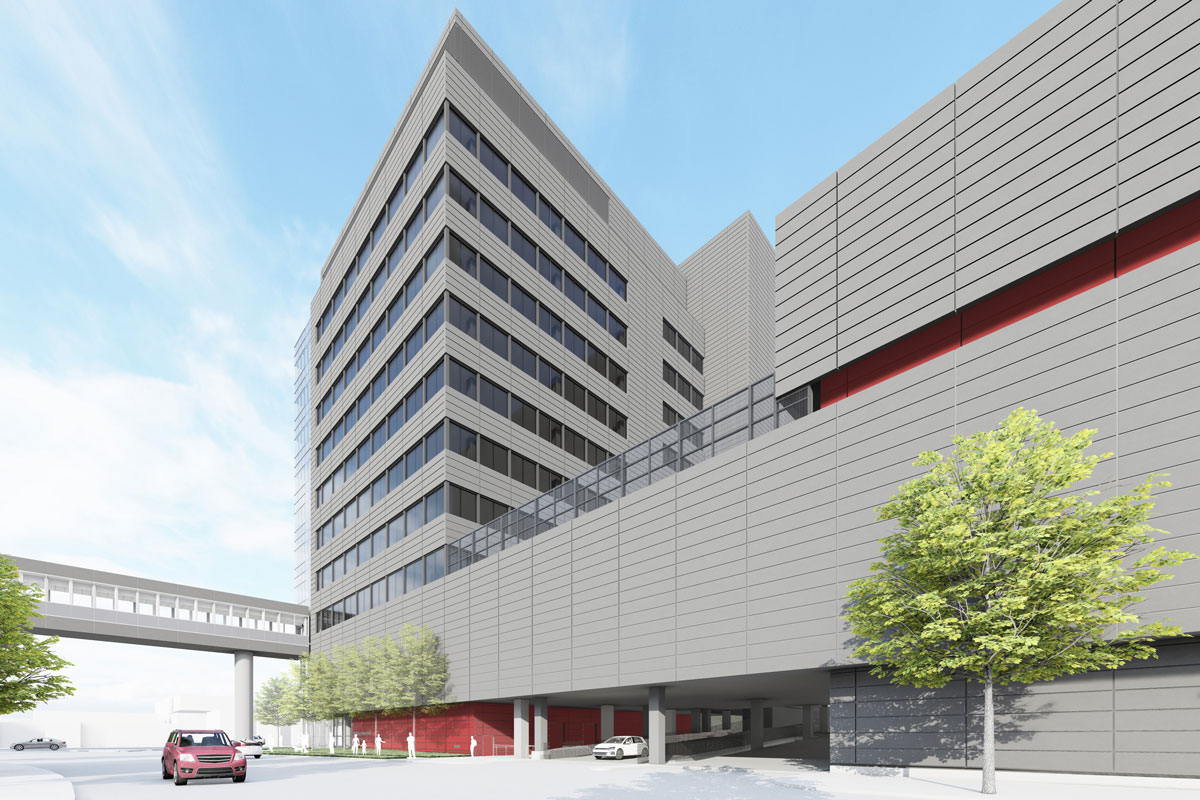Washington University to break ground on major neuroscience research hub
New construction will inspire discovery, collaboration, faculty recruitment at School of Medicine
Video by Huy Mach and Gaia RemerowskiWashington University in St. Louis will begin construction in March on an 11-story, 609,000-square-foot neuroscience research building on the School of Medicine campus. The project initially will bring together more than 100 research teams focused on solving the many mysteries of the brain and the body’s nervous system.
Washington University in St. Louis will begin construction in March on what will be one of the largest neuroscience research buildings in the country. Located on the School of Medicine campus, the 11-story, state-of-the-art research facility will merge, cultivate and advance some of the world’s leading neuroscience research.
The 609,000-square-foot facility and interconnected projects initially will bring together over 100 research teams focused on solving the many mysteries of the brain and the body’s nervous system. Those teams, comprising some 875 researchers, will come from a wide array of disciplines, including the medical school’s neurology, neuroscience, neurosurgery, psychiatry and anesthesiology departments.
“Washington University is one of the premier institutions in the world in neuroscience research, with faculty known for their contributions to the understanding of normal brain development, how nerve cells communicate, neuroimaging, neurological diseases such as Alzheimer’s disease, and surgical treatments for cerebral palsy, among other contributions,” said Chancellor Andrew D. Martin. “With this new building, we are able to offer the neuroscience community a central home and a laboratory environment that can inspire entirely new concepts that allow us to grasp a much deeper understanding of the brain and have a global impact on health and science.”
The School of Medicine has a long history as one of the world’s foremost centers for neuroscience research, including as a leading institution in the study of Alzheimer’s disease. Its scientists have identified key molecules involved in sculpting nervous system development and triggers of neurodegenerative diseases, mapped connections from brain region to brain region, and developed pioneering surgical treatments for nerve injuries, among other groundbreaking discoveries.
David H. Perlmutter, MD, executive vice chancellor for medical affairs, the George and Carol Bauer Dean of the School of Medicine, and the Spencer T. and Ann W. Olin Distinguished Professor, said the new facility will open the door to bold new research initiatives and partnerships.
“Understanding the brain is key to addressing some of the most devastating afflictions that affect mankind,” Perlmutter said. “So many of us have been touched by the inexorable decline of our loved ones due to diseases and conditions such as Alzheimer’s and Parkinson’s, brain trauma, glioblastoma and severe mental illness, and we have learned that the development of effective therapies has proven formidable. As scientists, we believe that a deeper understanding of cognition and emotional regulation can help us address major public health problems such as obesity, substance abuse, depression and suicide.”
The initiative will increase synergy and facilitate greater collaboration between scientists in the medical school’s neuroscience-focused departments and researchers in related disciplines, especially those whose work requires close collaboration with neuroscientists.
 Perkins and Will
Perkins and Will“Collaboration across disciplines will be key to advancing our understanding of this new frontier in medicine,” Perlmutter said. “For example, new studies have recognized the importance of the microbiome and its interaction with our immune system in shaping the development and function of the brain. Work on synaptic connections in the nervous system is also critical to the development of machine intelligence and socially interactive robots that could solve many of the most important challenges of modern society. This building will be dedicated to advancing our global leadership position in solving these very big problems with imagination and rigor.”
The new research center also is expected to inspire health-minded entrepreneurial pursuits and synergy with visionary business developers situated within a stone’s throw of the new research center. The building and related construction, which will be built at an expected cost of $616 million, will sit at the eastern edge of the Medical Campus, in the 200-acre Cortex Innovation Community, one of the fastest growing business, innovation and technology hubs in the United States and home to numerous biotech startups founded by Washington University faculty, staff and students.
“We are constructing the building at the intersection of Cortex and the Medical Campus to encourage efforts by Washington University neuroscientists to transform their research into innovations that can move rapidly to improve medical care and quality of life for people with neurological conditions,” said Jennifer K. Lodge, PhD, the university’s vice chancellor for research.
Among Washington University’s achievements in the field of neuroscience, two Nobel Prizes in Physiology or Medicine have been won by scientists at the university. In 1944, Joseph Erlanger and Herbert Gasser won the Nobel for their work studying nerve fibers. They showed that the conduction velocity of nerve impulses is faster in thick nerve fibers than in thin fibers, and identified numerous other properties of sensory and motor nerves. And in 1986, Stanley Cohen and Rita Levi-Montalcini won the Nobel for discovering chemical growth factors essential for cell growth and development in the body. In the 1950s, they discovered nerve growth factor, a protein crucial for building networks of nerves.
The School of Medicine has a longtime, deep commitment to understanding, treating and preventing Alzheimer’s in particular. In the U.S., 5.8 million people are living with the disease, with the number projected to rise to nearly 14 million by 2050. Alzheimer’s and other dementias cost the U.S. a staggering $290 billion in 2019, and the cost is predicted to climb as high as $1.1 trillion by 2050, according to the Alzheimer’s Association.
The new center is intended to complement and build on The Brain Research Advancing Innovative Neurotechnologies Initiative (The BRAIN Initiative), an extensive effort launched in 2013 by the National Institutes of Health (NIH) to revolutionize our understanding of the brain and brain disorders. Despite tremendous advances in neuroscience, the causes of numerous neurological and psychiatric conditions remain unknown. Like The BRAIN Initiative, Washington University’s leadership understands how critical that information will be to figuring out how to effectively counter these diseases and help the many people suffering from them. In fact, several research projects led by Washington University investigators are funded by The BRAIN Initiative and will find a home in the new neuroscience building.
The medical school’s faculty have long been lauded for the collaborations they develop across the university, and the new research facility is intended to boost and significantly drive such efforts. The building will feature research “neighborhoods” and a shared area on each floor to spur conversation and collaboration. The neighborhoods will be organized around research themes — among them, addiction, neurodegeneration, sleep and circadian rhythm, synapse and circuits, and neurogenomics and neurogenetics — that bring together people with common interests from multiple departments. The first researchers are slated to move into the building in 2023. While the initial construction will accommodate more than 100 research teams, additional shell space could be built out later for another 45 research teams.
 Perkins and Will
Perkins and WillThe additional space created in this building represents the next step in the school’s strategic plan to increase its research base by more than 30% over the next 10 years. The school is currently ranked fourth among U.S. medical schools in NIH funding and aims to leverage the breadth of its basic and clinical research assets, together with existing and new industry partnerships, to enhance its core mission in discovery and development of new treatments.
“We have been very successful at attracting top-notch researchers and their teams to the School of Medicine, and this continues to be a chief goal,” Perlmutter said. “The focus on neuroscience in this building is also integral to our aspirations across the Medical Campus to utilize the paradigm of personalized medicine and to address the problems of aging and degenerative diseases.”
Added David Holtzman, MD, the Andrew B. and Gretchen P. Jones Professor and head of the Department of Neurology: “A key goal for the neuroscience center is to take what we discover in our laboratories and get it out into the public sector so patients, and society as a whole, can benefit. This building and the collaborations it will grow will position us to achieve meaningful breakthroughs in science and medicine.”
An internationally renowned expert on the causes of Alzheimer’s disease, Holtzman and his team helped develop antibodies aimed at preventing dementia by reducing deposits of the Alzheimer’s proteins amyloid beta and tau in the brain, and have advanced the understanding of how sleep and apolipoprotein E — the most important genetic risk factor for Alzheimer’s — contribute to brain injury. Holtzman also is involved in a project led by Randall J. Bateman, MD, the Charles F. and Joanne Knight Distinguished Professor of Neurology, to develop a blood test that can measure levels of amyloid beta and other proteins in the blood with the goal of diagnosing Alzheimer’s before symptoms develop.
The new neuroscience facility — to be located at 4370 Duncan Avenue — extends the School of Medicine’s reach eastward. As part of the construction, the university will add to its network of elevated, connected walkways, known as the Link, to reach the neuroscience research hub, and also will build a utility plant. In addition to the facility’s labs and research-focused areas, the new building will have event space, a large seminar room and a food-service area, as well as an 1,860-space parking garage. The architectural firms Perkins and Will, and CannonDesign are the project’s designers, and McCarthy Building Companies will oversee construction.
“Neuroscience research is a synergetic enterprise that depends on the expertise of people in many fields,” Holtzman said. “By bringing together so much knowledge, talent and passion, this new facility will make it considerably more likely that people will have the kinds of water-cooler discussions that lead to interdisciplinary game-changing ideas and projects. I’m very excited to see what we will do.”
Neuroscience research highlights
Washington University researchers:
- Developed screening tests used worldwide to diagnose Alzheimer’s disease.
- Created the first positron emission tomography (PET) scanner to show how the brain and other organs function.
- Performed the first nerve transplant using tissue from a cadaver donor.
- Identified the triggers of nerve degeneration involved in conditions such as Parkinson’s disease, amyotrophic lateral sclerosis (ALS), multiple sclerosis (MS), glaucoma and peripheral neuropathy.
Through ongoing research, they are:
- Leading a global effort to map major brain circuits and identify their connection to brain disease.
- Exploring the genetic influences at play in alcohol, smoking and drug addiction.
- Developing new ways to diagnose and treat stroke and aneurysm.
- Leading an international collaboration to study inherited forms of Alzheimer’s and evaluating ways to prevent or delay onset of the disease.
- Investigating ways to create and improve nonaddictive treatments for chronic pain.






